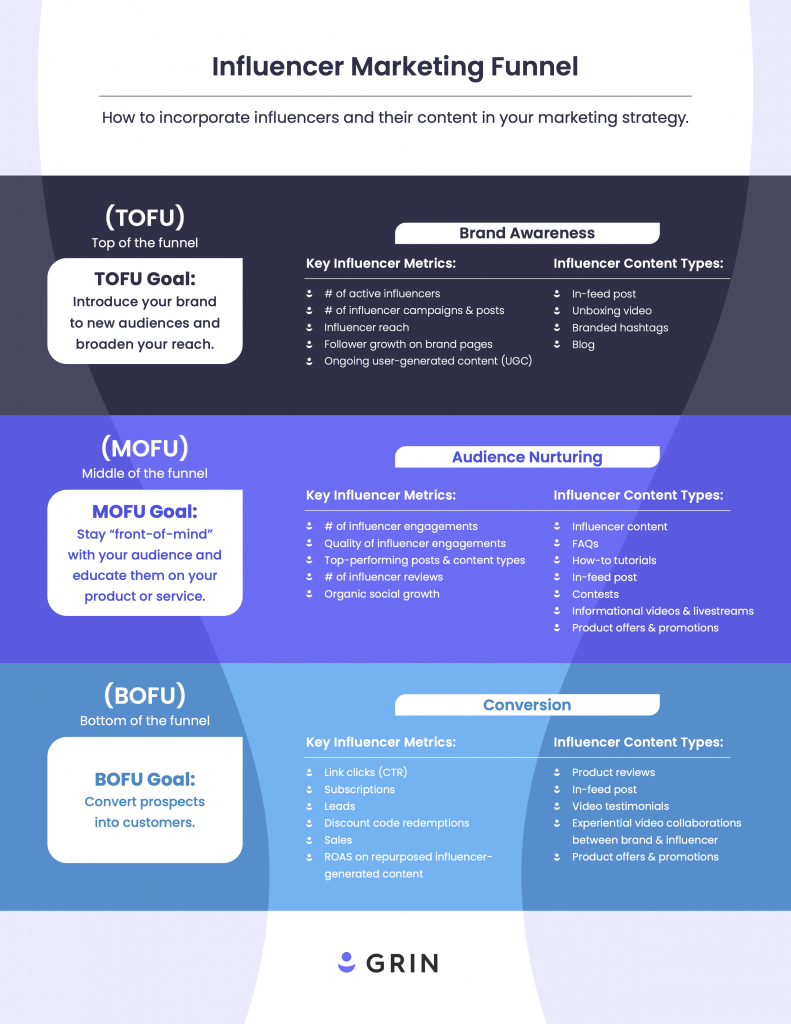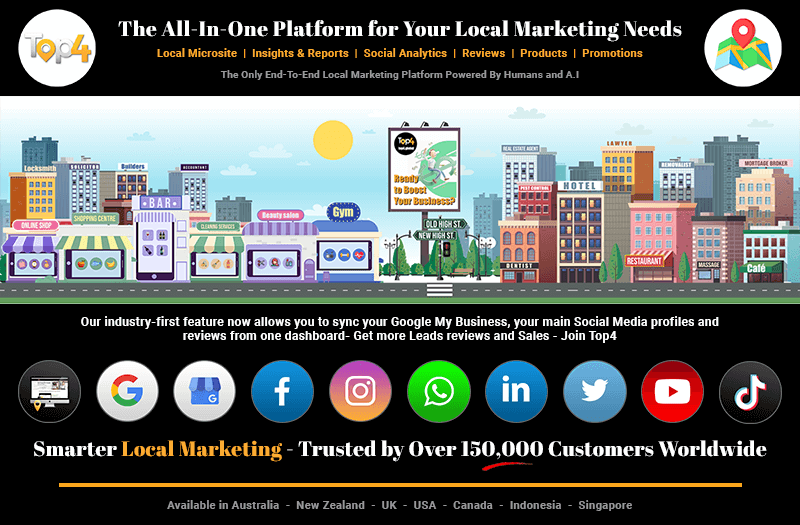Any marketing tactic, medium, or strategy you use must align with a greater marketing mindset that includes a mix – a marketing mix – of various components. Marketers today visualize this approach using the funnel.
From the marketing funnel, we get shorthand acronyms like TOFU, MOFU, and BOFU – each indicating where a post, ad, or campaign lies in a high-level effort to increase brand awareness, nurture audiences, and convert them into customers.

Influencer marketing ROI works much the same way. Without including influencer KPIs into broader marketing conversations, you risk going in a different direction from the rest of your marketing team.
A lopsided approach overemphasizes one stage of the funnel over another, thereby increasing customer acquisition costs, lowering retention, or both. Additionally, tunnel vision on a single stage of the funnel keeps you from seeing the bigger picture of your influencer ROI.
Influencer marketing is no longer in its infancy. Creator management solutions and attribution tools are catching up to demand. More importantly, recent developments in influencer campaign management demonstrate that influencer ROI is more extensive than experts previously thought.
For marketers just launching their influencer program or assessing their creator collaboration strategy, here is an influencer-specific marketing funnel with which to guide team discussions.
What is the influencer marketing funnel?
The purpose of an influencer marketing funnel is to track how your influencer campaigns impact your consumer touchpoints and buyer’s journey. Also, looking at the influencer marketing funnel can give you guidance on the right content for each stage of your customer journey.
As we all know, customers don’t get a brief look at your brand for the first time and immediately rush to buy your products. Buyers need time to feel comfortable with a brand and take a risk with that first purchase.
The more effective your marketing mix, the greater impact each touchpoint will have and the fewer touchpoints you’ll need to get your target audience from point A (brand awareness) to point B (conversions).
The great advantage of influencer-generated content is that it is usually more authentic than branded content. Social media creators straddle the fence of celebrity status and informed consumer. Followers trust their favourite influencers with their purchasing decisions if that influencer exudes genuine brand love and publishes compelling lifestyle content featuring their favourite brands.
In other words, influencer campaigns don’t just offer you another medium for connecting with audiences, they can significantly lower your costs and increase your bottom line. The influencer marketing funnel will help you visualize where your program ROI comes from.
Once examining the current state of your influencer program, you can use the funnel below to refine your influencer outreach, program goals, and campaign workflows to improve ROI over time.

Top-of-the-funnel: Influencer-generated brand awareness
Influencer campaigns tagged as “top-of-funnel” are introducing your brand to new people within your target audience.
Key TOFU Metrics
- Number of active influencers: This metric often indicates the size of your influencer program. Improving this KPI means acquiring better influencer management support (tools, budget, and team members) to accomplish more relationship-building tasks with fewer clicks.
- Number of influencer campaigns and posts: Your influencer campaigns and content volume also signal the size of your program. Scaling your program from a campaign perspective requires hacking program inefficiencies with the help of automation software.
- Influencer reach: An influencer’s follower count is often the best way to gauge that creator’s reach. That said, pay careful attention to the quality of their follower engagement. Impressions are worthless if there’s no real relationship between an influencer and their audience.
- Follower growth on brand pages: It’s a good sign when an influencer’s fans become your fans. This metric is an example of the influencer halo effect, where someone’s affinity for one brand overflows onto whatever that brand promotes – in this case, followers emulate an influencer’s excitement over a particular product.
- Ongoing user-generated content: Content that resonates with an audience inspires reactions, comments, and shares. A single piece of viral content can spread like wildfire across your target audience. UGC is a great way to track your influencer’s viral success. This UGC also contributes to your organic social growth (more brand followers and engagements).
Middle-of-the-funnel: Using influencers to inform & nurture audiences
Campaigns that are “middle-of-funnel” will leverage influencer content to build relationships with members of your audience who’ve already heard your brand name a few times. These individuals can recognize your brand, though they may not fully trust your brand just yet.
Key MOFU Metrics
- Number of influencer engagements: Follower reactions, comments, and shares indicate how well your influencer content is resonating with your audience.
- Quality of influencer engagements: Taking a closer look at what your influencer content engagement looks like will help you weed out a fraudulent activity (fake followers), as well as identify your top-performers.
- Top-performing posts: These posts signal how well your influencer campaigns are being consumed by your audience. It can also indicate which types of content are most effective for moving buyers through your marketing funnel.
- Number of influencer reviews: It’s critical that your influencer program includes content that showcases product strengths/weaknesses, case uses, before/after, etc. Most consumers rely on this type of content to visualize how your product will improve their overall quality of life.
- Organic social growth: If your influencer’s audience and tone of voice are aligned with your brand, you will notice a strong correlation between that influencer’s performance and your own social growth.
Bottom-of-the-funnel: Influencer-generated sales & conversions
“Bottom-of-funnel” metrics require very little explanation. Marketers, sales staff, and C-suite executives alike understand the value of conversions.
That said, tracking conversions against the backdrop of your marketing funnel ensures that influencer-generated conversions come at a lower cost per customer (CAC) and extend that customer’s lifetime value (CLV).
Key BOFU Metrics
- Number of link clicks and click-through rate: A link click is a significant action taken by a member of your audience. Link clicks can also contribute to your web traffic and paid remarketing efforts.
- Subscriptions: An email, SMS, or notification subscription often signals future purchases. Timing matters in sales, and when members of your audience subscribe, it means that they are interested in making that first or repeat purchase at some point.
- Leads: For longer sales journeys, qualified leads are worth their weight in gold by improving your close rates and lowering your customer churn.
- Discount code redemptions: Coupon codes are a widely accepted way to track influencer attribution. And the great thing about these codes is that they drive direct sales.
- Sales: Sales as a BOFU metric is not difficult to appreciate. But what can be a challenge for many influencer programs is knowing which sales came from which creator. Whether using affiliate links, discount codes, or another influencer platform tool, it’s important to keep track of your influencer-generated revenue. Not only does this affect influencer payments (i.e. commissions) but it also gives you the numbers you need to pitch a bigger influencer budget to your superiors.
- Return on ad spend on repurposed influencer-generated content: Creator content frequently makes better-quality ad content than traditional production companies or agencies. Additionally, influencers are more affordable. Measuring the performance of your repurposed influencer content helps you see the bigger picture of how your program impacts your overall marketing ROI.
Influencer Marketing Funnel – Key Takeaways
As you apply this influencer marketing funnel to your program, here are a few things to keep in mind.
- Direct brand-influencer relationships outperform influencer networks every time. Networks and agencies either don’t provide the performance metrics listed above or hold that information close to the chest. Engaging creators directly helps you find your ideal influencers and gather firsthand accounts of each campaign’s performance.
- Authentic brand-influencer relationships translate into authentic influencer content. These relationships come from proper vetting and communication with the right influencers. By contrast, the wrong influencers and a laissez-faire approach to influencer management is a waste of time and resources. Consumers can smell inauthenticity in an influencer’s content. Healthy brand-influencer relationships translate into genuine brand love.
- You can’t track success without creating marketing goals and KPIs. Establishing marketing goals tells you and your influencers what you want them to accomplish. Key performance indicators break those goals down into actionable milestones.
- Additionally, you can’t track ROI without assigning the right performance metrics to each marketing KPI. Every marketing KPI should include a number and a deadline. Whatever tools you use to manage your influencer campaigns need to provide you with the right metrics to know whether you are meeting your KPIs.
At a certain point, you can’t manage your influencer program well using spreadsheets and manual tools. For newer, smaller influencer programs, spreadsheets and manual tracking work well and save money. But once you’re managing a team of influencers, these tools will drain your time and energy. To scale your program without drastically increasing your work hours, you’ll need to adopt an influencer management solution that fits your program needs and goals.
To find out how we can help you with your Website + Marketing, using our unique location marketing platform called Top4, get in touch today at www.top4marketing.com.au

Looking to build customer loyalty through social media? Don’t forget to add your business to Top4.com.au
List your business, create your own digital store to sell goods and services, and share posts on social media. Promote your business on Google instantly! Should you need help with local digital marketing then view our new Google Marketing Platform and services Top4 Marketing
Get Found On Google Promote Your Website, Reach local customers today!
Our Digital Marketing Agency Services Across All Industries Include Search Engine Optimisation (SEO), Google Marketing, Website Design, Corporate Web Development, and local location-based marketing using our own Google Marketing Platform!
Engage A Social Media Agency For Only 1/3 The Cost Of Employing A Social Media Manager…LET’S TALK!
Source: business2community




